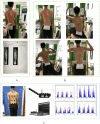Immediate Effects of the Schroth Method on Spinal Curvature and Paravertebral Muscle Activation in Adolescent Idiopathic Scoliosis
- PMID: 40491181
- PMCID: PMC12214401
- DOI: 10.1111/os.70096
Immediate Effects of the Schroth Method on Spinal Curvature and Paravertebral Muscle Activation in Adolescent Idiopathic Scoliosis
Abstract
Objectives: The Schroth method is considered potentially valuable as an alternative intervention to control curve progression in mild to moderate adolescent idiopathic scoliosis. However, patients are often dependent on the subjective experience of the physiotherapist when practicing, as changes in spinal alignment and muscle activation are unknown. The aim of this study was to evaluate the effectiveness of the Schroth method for spinal alignment and muscle activation in adolescents with idiopathic scoliosis (AIS).
Methods: This prospective cross-sectional study, conducted at the Scoliosis Engineering Center of Guangzhou Sport University (January 2020-October 2022), enrolled 36 AIS (4 males, 32 females; age 13.2 ± 1.8 years) presenting major thoracic curvature (Cobb angle: 10°-40°, Risser stage 0-4). Participants underwent a standardized 1-week pretraining protocol before performing four Schroth exercises ("50 × Pezziball," sail, muscle cylinder, and corrected standing). Real-time spinal ultrasound angles (SUAs) and paraspinal muscle activation (via surface electromyography, sEMG) were quantified during habitual standing (baseline) and exercise conditions. Normality was verified using Kolmogorov-Smirnov tests. Within-group comparisons employed paired t-tests (effect sizes: Cohen's d; 95% CIs), while proximal thoracic (PT) compensation frequencies were assessed via chi-squared tests.
Results: All four Schroth exercises significantly reduced the SUA of the primary thoracic curve compared to habitual standing (p < 0.05). The lumbar curve SUA decreased specifically after "50 × Pezziball" and muscle cylinder exercises (p < 0.05). PT curve compensation frequency rose from 16.7% (6/36) in habitual standing to 33.3% (12/36) and 30.6% (11/36) during "50 × Pezziball" and sail exercises, respectively (p < 0.05). sEMG demonstrated reduced paravertebral muscle (PSM) activation asymmetry at the thoracic apex (T8) during corrective standing, "50 × Pezziball," and sail exercises (p < 0.05). However, "50 × Pezziball" and sail exercises triggered compensatory left-dominant PSM imbalance at T2 (p < 0.05). At lumbar levels (L2-L5), performing 50 × Pezziball exercise exacerbated asymmetry (p < 0.05), whereas muscle cylinder exercises reversed the activation patterns of the PSM (p < 0.05).
Conclusion: While Schroth exercises effectively reduced thoracic curvature and improved T8 muscle symmetry, caution is warranted during "50 × Pezziball" and sail exercises due to increased PT compensation and lumbar/T2 muscle imbalances. Muscle cylinder exercises may mitigate adverse lumbar effects.
Keywords: Schroth method; adolescent idiopathic scoliosis; surface myoelectricity; three‐dimensional spinal ultrasound.
© 2025 The Author(s). Orthopaedic Surgery published by Tianjin Hospital and John Wiley & Sons Australia, Ltd.
Conflict of interest statement
The authors declare no conflicts of interest.
Figures


Similar articles
-
Asymmetry in the Onset of Paraspinal Muscles Activity Differs in Adolescents With Idiopathic Scoliosis Compared With Those With a Symmetrical Spine.Clin Orthop Relat Res. 2025 Jun 1;483(6):1112-1121. doi: 10.1097/CORR.0000000000003364. Epub 2025 Jan 7. Clin Orthop Relat Res. 2025. PMID: 39774429
-
Comparative efficacy of six types of scoliosis-specific exercises on adolescent idiopathic scoliosis: a systematic review and network meta-analysis.BMC Musculoskelet Disord. 2024 Dec 26;25(1):1070. doi: 10.1186/s12891-024-08223-1. BMC Musculoskelet Disord. 2024. PMID: 39725973 Free PMC article.
-
Effectiveness of Schroth exercises for adolescent idiopathic scoliosis: a meta-analysis.PeerJ. 2025 Jul 8;13:e19639. doi: 10.7717/peerj.19639. eCollection 2025. PeerJ. 2025. PMID: 40656945 Free PMC article.
-
Associations between paraspinal muscle characteristics and spinal curvature in conservatively treated adolescent idiopathic scoliosis: a systematic review.Spine J. 2024 Apr;24(4):692-720. doi: 10.1016/j.spinee.2023.11.008. Epub 2023 Nov 24. Spine J. 2024. PMID: 38008187
-
Exercises for adolescent idiopathic scoliosis.Cochrane Database Syst Rev. 2012 Aug 15;2012(8):CD007837. doi: 10.1002/14651858.CD007837.pub2. Cochrane Database Syst Rev. 2012. Update in: Cochrane Database Syst Rev. 2024 Feb 28;2:CD007837. doi: 10.1002/14651858.CD007837.pub3. PMID: 22895967 Free PMC article. Updated.
Cited by
-
Extent of fatty infiltration in lumbar paraspinal muscles in adults with degenerative scoliosis: segmental differences in muscle involvement.Eur Spine J. 2025 Jul 21. doi: 10.1007/s00586-025-09165-5. Online ahead of print. Eur Spine J. 2025. PMID: 40689985
References
-
- Fong D. Y. T., Lee C. F., Cheung K. M. C., et al., “A Meta‐Analysis of the Clinical Effectiveness of School Scoliosis Screening,” Spine (Phila Pa 1976) 35, no. 10 (2010): 1061–1071. - PubMed
-
- Smit T. H., “On Growth and Scoliosis,” European Spine Journal 33 (2024): 2439–2450. - PubMed
-
- Weinstein S. L. and Ponseti I. V., “Curve Progression in Idiopathic Scoliosis,” Journal of Bone and Joint Surgery. American Volume 65 (1983): 447–455. - PubMed
-
- Schreiber S., Parent E. C., Khodayari Moez E., et al., “Schroth Physiotherapeutic Scoliosis‐Specific Exercises Added to the Standard of Care Lead to Better Cobb Angle Outcomes in Adolescents With Idiopathic Scoliosis – An Assessor and Statistician Blinded Randomized Controlled Trial,” PLoS One 11, no. 12 (2016): e0168746. - PMC - PubMed
MeSH terms
Grants and funding
- 2024ZDZX2064/Key Research Platform and Project of Guangdong Provincial Department of Education
- Higher Education Teaching Reform Project of Guangdong Provincial Department of Education (Strategy and practice exploration of innovative training mode for sports rehabilitation professionals under the guidance of supply-side reform)
- 2023A04J0554/The Basic and Applied Basic Research Project of Guangzhou City
- 2023B04J0466/Guangzhou Sports Science and Technology Collaborative Innovation Center
- 2021B1212040014/Open Fund of the Guangdong Provincial Key Laboratory of Physical Activity and Health Promotion
LinkOut - more resources
Full Text Sources
Medical
Miscellaneous

